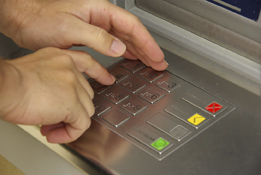Discover

iStockphoto/Thinkstock
If your Personal Identification Number (PIN) consists of four digits, how long do you think it would take a thief to hack your number? In theory there are 10 000 possible PINs available but, in reality, most banks have restrictions on what digits may be used. Most bank machines only allow three attempts to get the correct PIN, so there is only a 0.06% chance of a thief getting the correct number before the machine locks the crook out.
Try This 1
Abdy received a new chip-enabled credit card. In order to activate the card, Abdy has to choose a PIN. Abdy has several PINs: one for his bank card, one to unlock his telephone, and some for his other credit cards. To make it easier to remember all his pass codes, Abdy always uses an arrangement of his birth date for his PIN. Abdy was born on January 7, 1996. Because of his birth date, Abdy always uses a 1 or a 7 for the first digit, a 9 or a 6 for the second digit, a 1 or a 7 for the third digit, and, finally, a 9 or a 6 for the last digit.
Using Abdy’s restrictions, how many different four-digit PINs are possible? ![]()
![]() Save your responses in your course folder.
Save your responses in your course folder.
Share 1
With a partner or in a group, discuss the following.
- How many PINs are possible?
- Was there a more efficient way used by one of the group members for determining the number of PINs rather than writing them all out?
- Apply the most efficient method you discussed to show how 10 000 possible four-digit PINs can be created when any digit from 0 to 9 can be used in any order.
![]() If required, save a copy of your discussion in your course folder.
If required, save a copy of your discussion in your course folder.